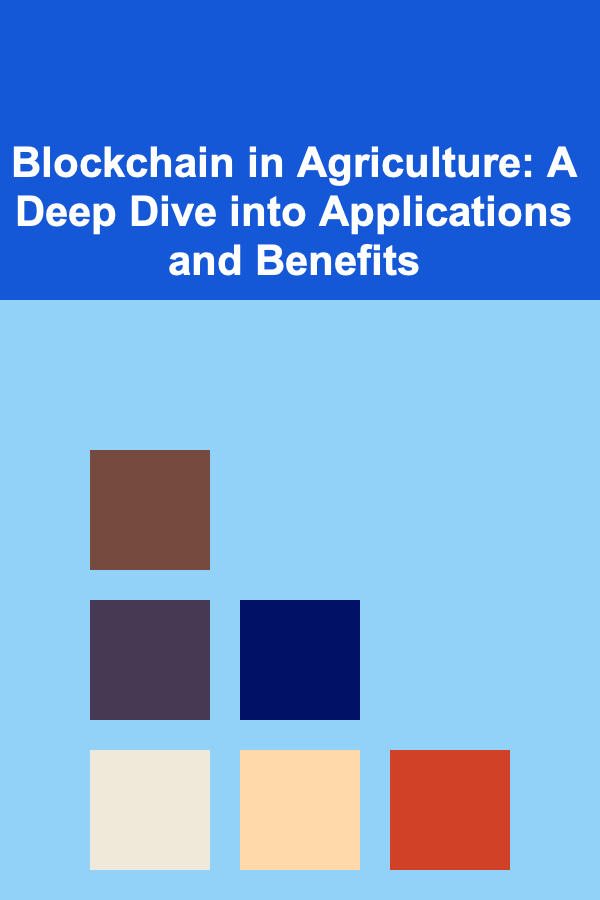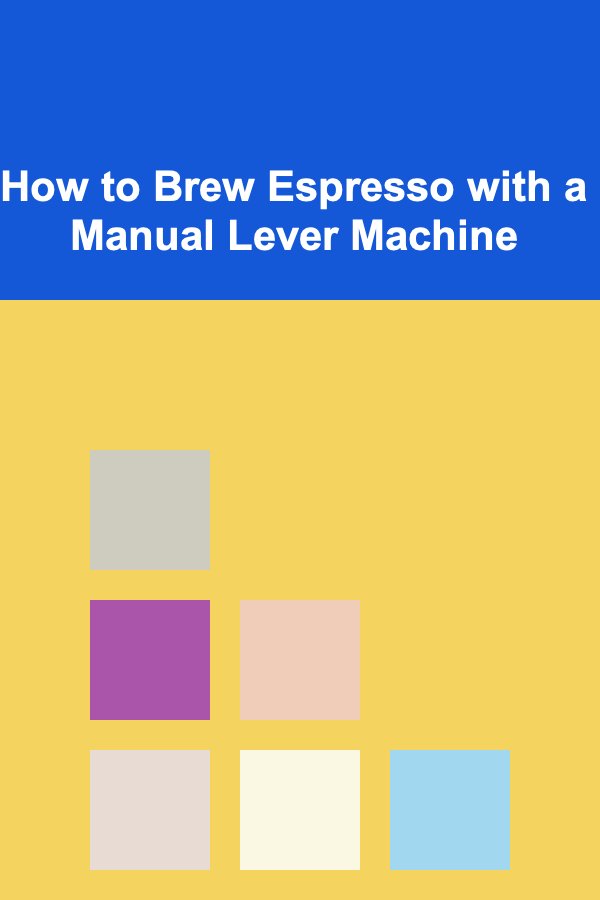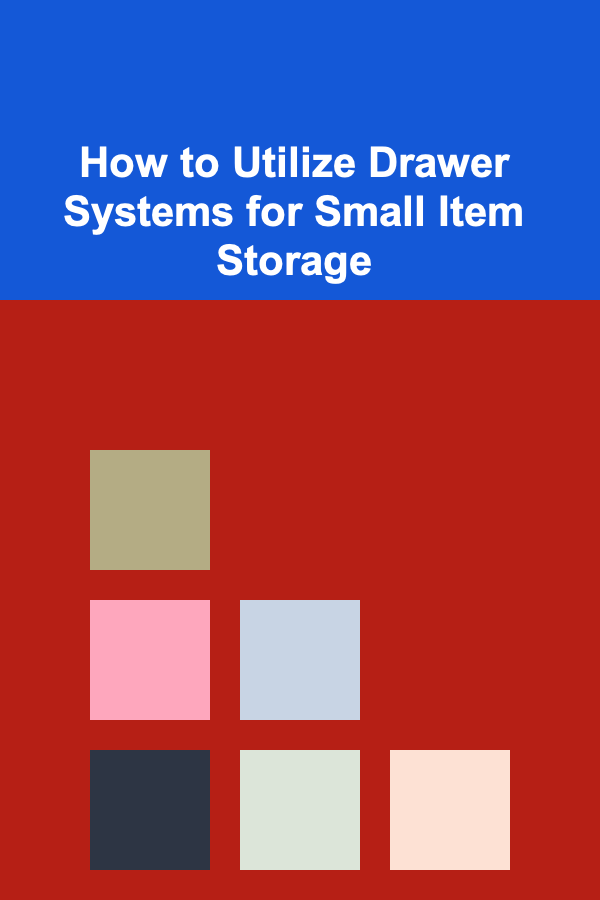
Blockchain in Agriculture: A Deep Dive into Applications and Benefits
ebook include PDF & Audio bundle (Micro Guide)
$12.99$5.99
Limited Time Offer! Order within the next:

The agricultural sector, a cornerstone of global food security and economic stability, faces numerous challenges in the 21st century. These include supply chain inefficiencies, lack of transparency, food safety concerns, difficulty in accessing finance for smallholder farmers, and the impact of climate change. Blockchain technology, with its inherent properties of immutability, transparency, and decentralization, offers a promising solution to address many of these challenges and revolutionize the way we produce, distribute, and consume food. This article provides a comprehensive exploration of how blockchain can be used in agriculture, examining its potential applications, benefits, challenges, and future prospects.
Understanding Blockchain Fundamentals
Before delving into the specific applications of blockchain in agriculture, it's crucial to understand the fundamental principles that underpin this technology. At its core, a blockchain is a distributed, immutable ledger that records transactions in a secure and transparent manner. Let's break down these key concepts:
- Distributed Ledger Technology (DLT): Instead of relying on a central authority to maintain the ledger, blockchain utilizes a network of computers (nodes) that each hold a copy of the entire ledger. This distributed nature eliminates single points of failure and enhances security.
- Immutability: Once a transaction is recorded on the blockchain, it cannot be altered or deleted. This is achieved through cryptographic hashing, where each block of transactions contains a unique hash value that is linked to the hash value of the previous block, forming a chain. Any attempt to modify a block would change its hash value, breaking the chain and alerting all participants in the network.
- Transparency: All transactions recorded on the blockchain are publicly viewable and auditable, although the identities of the parties involved may be anonymized through the use of cryptographic keys. This transparency promotes trust and accountability among stakeholders.
- Decentralization: The lack of a central authority controlling the blockchain eliminates intermediaries and reduces the risk of censorship or manipulation. The network operates based on consensus mechanisms, such as Proof-of-Work (PoW) or Proof-of-Stake (PoS), to validate transactions and add new blocks to the chain.
These characteristics make blockchain a powerful tool for addressing trust issues, enhancing transparency, and improving efficiency in various industries, including agriculture.
Key Applications of Blockchain in Agriculture
Blockchain technology offers a wide range of applications across the agricultural value chain, from farm to fork. Here are some of the most promising areas where blockchain is already making a significant impact:
1. Supply Chain Traceability and Transparency
One of the most compelling applications of blockchain in agriculture is its ability to track and trace agricultural products throughout the supply chain. This is particularly important in addressing concerns about food safety, origin verification, and ethical sourcing. By recording information about each stage of the product's journey -- from planting and harvesting to processing, transportation, and retail -- on the blockchain, consumers can gain access to detailed information about the food they are consuming.
How it Works:
- Each participant in the supply chain (farmers, processors, transporters, retailers) uses a blockchain platform to record relevant data about the product at each stage.
- This data can include information such as farm location, planting date, harvesting date, processing details, transportation temperature, and storage conditions.
- QR codes or RFID tags can be attached to the product, allowing consumers to scan them with their smartphones and access the blockchain data.
- The immutable nature of the blockchain ensures that the data cannot be tampered with, providing a reliable record of the product's journey.
Benefits:
- Enhanced Food Safety: By tracing the origin of contaminated products, blockchain can help identify the source of outbreaks and prevent further spread of disease.
- Improved Quality Control: Tracking environmental conditions and handling practices throughout the supply chain allows for better quality control and reduces the risk of spoilage.
- Origin Verification: Consumers can verify the authenticity of products and ensure that they are sourced from ethical and sustainable farms.
- Increased Consumer Trust: Transparency in the supply chain builds trust between consumers and producers, leading to increased brand loyalty.
- Reduced Fraud: Blockchain can help prevent the mislabeling of products and the substitution of inferior ingredients.
Examples:
- Walmart: Walmart has implemented a blockchain-based system to track the origin of mangoes and pork in its supply chain. This has enabled them to trace the origin of contaminated products in seconds, compared to days or weeks using traditional methods.
- IBM Food Trust: IBM Food Trust is a blockchain platform that connects farmers, suppliers, processors, distributors, and retailers to improve food traceability and safety.
- Carrefour: Carrefour uses blockchain to track the journey of various products, including chicken, milk, and tomatoes, providing consumers with detailed information about their origin and production methods.
2. Improving Farmer Access to Finance
Smallholder farmers in developing countries often struggle to access financing due to a lack of credit history, collateral, and reliable documentation. Blockchain technology can help overcome these barriers by providing a transparent and verifiable record of farmers' activities, enabling lenders to assess their creditworthiness more accurately.
How it Works:
- Farmers can record their farming practices, yields, and sales data on a blockchain platform.
- This data can be used to create a digital identity and credit history for the farmer.
- Lenders can access this information to assess the farmer's creditworthiness and make informed lending decisions.
- Smart contracts can be used to automate loan disbursement and repayment, reducing administrative costs and improving efficiency.
Benefits:
- Increased Access to Credit: Blockchain-based credit scoring can help smallholder farmers access loans that they would otherwise be unable to obtain.
- Lower Interest Rates: By reducing the risk of lending, blockchain can help lower interest rates for farmers.
- Reduced Transaction Costs: Smart contracts can automate loan processes, reducing administrative costs and improving efficiency.
- Financial Inclusion: Blockchain can help bring unbanked farmers into the formal financial system.
- Improved Farmer Productivity: Access to finance allows farmers to invest in better inputs, technologies, and practices, leading to increased productivity.
Examples:
- AgriLedger: AgriLedger is a blockchain platform that helps smallholder farmers in Haiti access financing by creating a transparent and verifiable record of their transactions.
- Hello Tractor: Hello Tractor uses blockchain to track the usage of tractors by smallholder farmers, enabling them to access financing for tractor services.
- BanQu: BanQu uses blockchain to create a digital identity and transaction history for farmers, enabling them to access financial services and participate in global supply chains.
3. Streamlining Agricultural Insurance
Traditional agricultural insurance schemes are often plagued by inefficiencies, high administrative costs, and delays in claims processing. Blockchain can help streamline the insurance process, reduce fraud, and improve the efficiency of payouts.
How it Works:
- Smart contracts can be used to automate the insurance process, from policy issuance to claims processing.
- Data from weather sensors, satellite imagery, and IoT devices can be used to automatically trigger payouts when pre-defined thresholds are met.
- The immutable nature of the blockchain ensures that insurance policies and claims data cannot be tampered with.
Benefits:
- Automated Claims Processing: Smart contracts can automatically process claims based on pre-defined conditions, reducing delays and administrative costs.
- Reduced Fraud: The immutable nature of the blockchain makes it difficult to file fraudulent claims.
- Faster Payouts: Automated claims processing allows for faster payouts to farmers affected by adverse weather events or other disasters.
- Increased Transparency: All insurance policies and claims data are publicly viewable on the blockchain, promoting transparency and accountability.
- Affordable Insurance: Reduced administrative costs can make insurance more affordable for smallholder farmers.
Examples:
- Etherisc Crop Insurance: Etherisc Crop Insurance is a decentralized insurance platform that uses blockchain and smart contracts to automate the crop insurance process.
- Acre Africa: Acre Africa uses blockchain and satellite data to provide index-based insurance to smallholder farmers in East Africa.
4. Enhancing Supply Chain Management and Logistics
Efficient supply chain management is crucial for ensuring that agricultural products reach consumers in a timely and cost-effective manner. Blockchain can help optimize supply chain logistics by providing real-time visibility into the movement of goods, reducing delays, and minimizing waste.
How it Works:
- IoT devices can be used to track the location, temperature, and humidity of agricultural products throughout the supply chain.
- This data is recorded on the blockchain, providing real-time visibility to all stakeholders.
- Smart contracts can be used to automate logistics processes, such as inventory management and payments.
Benefits:
- Real-Time Visibility: Stakeholders can track the location and condition of agricultural products in real-time, improving efficiency and reducing delays.
- Reduced Waste: By monitoring temperature and humidity, blockchain can help prevent spoilage and reduce food waste.
- Optimized Inventory Management: Real-time data on inventory levels allows for better inventory management and reduces the risk of stockouts or overstocking.
- Automated Payments: Smart contracts can automate payments between stakeholders, reducing administrative costs and improving efficiency.
- Improved Collaboration: Blockchain facilitates collaboration between different stakeholders in the supply chain by providing a shared and transparent platform for communication and data sharing.
Examples:
- OriginTrail: OriginTrail is a blockchain-based supply chain platform that tracks the movement of goods from origin to consumer, providing real-time visibility and transparency.
- Ambrosus: Ambrosus is a blockchain-based platform for tracking the quality and authenticity of food and pharmaceuticals.
5. Facilitating Fair Trade and Ethical Sourcing
Blockchain can be used to promote fair trade and ethical sourcing by providing consumers with verifiable information about the origin and production methods of agricultural products. This allows consumers to make informed purchasing decisions and support farmers who adhere to fair labor practices and environmental standards.
How it Works:
- Farmers and producers can record information about their farming practices, labor conditions, and environmental certifications on the blockchain.
- Consumers can access this information by scanning QR codes or other identifiers on the product packaging.
- The immutable nature of the blockchain ensures that the information is accurate and cannot be tampered with.
Benefits:
- Increased Transparency: Consumers can verify that products are sourced from ethical and sustainable farms.
- Empowerment of Farmers: Farmers can receive fair prices for their products and build direct relationships with consumers.
- Promotion of Sustainable Practices: Blockchain can incentivize farmers to adopt sustainable farming practices by providing them with a competitive advantage in the market.
- Reduced Exploitation: By providing transparency into labor conditions, blockchain can help prevent exploitation of workers in the agricultural sector.
- Enhanced Consumer Trust: Consumers are more likely to trust products that are certified as fair trade and ethically sourced.
Examples:
- Fairfood: Fairfood uses blockchain to track the origin and production of coffee, ensuring that farmers receive fair prices for their products.
- Provenance: Provenance uses blockchain to track the journey of various products, including seafood and clothing, providing consumers with information about their origin and ethical sourcing.
6. Improving Land Registry and Ownership
In many developing countries, land ownership is poorly documented, leading to disputes and insecurity. Blockchain can provide a secure and transparent system for recording land ownership rights, reducing the risk of fraud and improving access to land for smallholder farmers.
How it Works:
- Land ownership records are stored on a blockchain, creating a secure and immutable record of ownership.
- Transactions involving land ownership are recorded on the blockchain, ensuring transparency and accountability.
- Smart contracts can be used to automate land transfers and other related processes.
Benefits:
- Secure and Transparent Land Records: Blockchain provides a secure and transparent system for recording land ownership, reducing the risk of fraud and disputes.
- Improved Access to Land: Clear and secure land ownership rights can improve access to land for smallholder farmers.
- Reduced Corruption: Transparency in land ownership can help reduce corruption in the land administration process.
- Economic Development: Secure land ownership rights can promote economic development by encouraging investment in agriculture and other sectors.
Examples:
- Georgia Land Registry: The Republic of Georgia is using blockchain to create a secure and transparent land registry system.
- Hernando de Soto Polar's work: Economist Hernando de Soto Polar has long advocated for formalizing property rights as a key to economic development, and blockchain offers a potential solution for achieving this goal.
Challenges and Considerations for Implementing Blockchain in Agriculture
While blockchain holds immense potential for transforming the agricultural sector, it's important to acknowledge the challenges and considerations that need to be addressed for successful implementation:
- Scalability: Blockchain networks can face scalability issues, particularly when dealing with a large volume of transactions. This is a significant concern for agricultural supply chains, which often involve numerous transactions and participants. Solutions like layer-2 scaling solutions (e.g., payment channels, sidechains) and more efficient consensus mechanisms are being explored to address this challenge.
- Interoperability: Different blockchain platforms may not be compatible with each other, making it difficult to share data and collaborate across different supply chains. Efforts are needed to develop interoperability standards that allow different blockchain networks to communicate with each other seamlessly.
- Data Privacy: While blockchain promotes transparency, it's also important to protect the privacy of sensitive data, such as farm location and production yields. Privacy-enhancing technologies, such as zero-knowledge proofs and homomorphic encryption, can be used to address this concern.
- Data Accuracy and Integrity: The data recorded on a blockchain is only as accurate as the information provided by the participants. It's important to implement mechanisms to ensure the accuracy and integrity of the data, such as using trusted data sources and implementing verification processes. The "garbage in, garbage out" principle applies just as strongly to blockchain as to any other data system.
- Digital Literacy and Infrastructure: Adoption of blockchain technology requires a certain level of digital literacy and access to reliable internet connectivity. This can be a challenge in developing countries where digital literacy rates are low and internet infrastructure is limited. Training programs and investments in infrastructure are needed to overcome these barriers.
- Regulatory Uncertainty: The regulatory landscape for blockchain technology is still evolving, and there is uncertainty about how blockchain applications in agriculture will be regulated. Clear and consistent regulations are needed to provide clarity and promote innovation.
- Cost: Implementing and maintaining blockchain solutions can be costly, particularly for smallholder farmers and small businesses. Cost-effective solutions and financial incentives are needed to encourage adoption.
- Complexity: Blockchain technology can be complex to understand and implement. User-friendly interfaces and simplified solutions are needed to make it accessible to a wider audience.
The Future of Blockchain in Agriculture
Despite the challenges, the future of blockchain in agriculture looks promising. As the technology matures and adoption increases, we can expect to see even more innovative applications emerge. Here are some of the potential future trends:
- Increased Adoption: As awareness of the benefits of blockchain grows, we can expect to see increased adoption across the agricultural sector.
- Integration with IoT and AI: Blockchain will be increasingly integrated with other technologies, such as the Internet of Things (IoT) and Artificial Intelligence (AI), to create more sophisticated and automated solutions. For example, IoT sensors can collect data on soil conditions and weather patterns, which can be used to optimize irrigation and fertilization, and this data can be recorded on the blockchain for transparency and traceability. AI can analyze this data to predict crop yields and optimize supply chain logistics.
- Development of Specialized Blockchain Platforms: We can expect to see the development of more specialized blockchain platforms that are tailored to the specific needs of the agricultural sector.
- Greater Collaboration: Increased collaboration between farmers, researchers, technology providers, and policymakers will be crucial for driving innovation and adoption of blockchain in agriculture.
- Focus on Sustainability: Blockchain will play an increasingly important role in promoting sustainable agricultural practices and reducing the environmental impact of food production.
- Decentralized Finance (DeFi) in Agriculture: The principles of DeFi could be applied to agriculture, creating decentralized lending platforms, insurance products, and marketplaces, offering farmers greater control and access to financial services.
- Tokenization of Agricultural Assets: The ability to represent agricultural commodities and resources as digital tokens on a blockchain could revolutionize trading, investment, and supply chain finance in the sector.
Conclusion
Blockchain technology has the potential to revolutionize the agricultural sector by enhancing transparency, improving efficiency, and fostering trust among stakeholders. From supply chain traceability and improved access to finance to streamlined insurance and enhanced supply chain management, blockchain offers a wide range of benefits for farmers, consumers, and the environment. While there are challenges to overcome, the future of blockchain in agriculture is bright. By addressing these challenges and fostering collaboration, we can unlock the full potential of this transformative technology and create a more sustainable and equitable food system for all.

How to Brew Espresso with a Manual Lever Machine
Read More
How to Create a Beauty Bar for Luxury Cosmetics
Read More
How to Use Task Lighting for Functional and Stylish Spaces
Read More
How to Utilize Drawer Systems for Small Item Storage
Read More
How to Write a Persuasive Follow-Up Email
Read More
How to Create Abstract Mosaic Art Designs
Read MoreOther Products

How to Brew Espresso with a Manual Lever Machine
Read More
How to Create a Beauty Bar for Luxury Cosmetics
Read More
How to Use Task Lighting for Functional and Stylish Spaces
Read More
How to Utilize Drawer Systems for Small Item Storage
Read More
How to Write a Persuasive Follow-Up Email
Read More